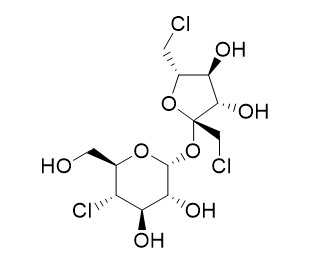Sucralose
Sucralose, an intense artificial sweetener, may induce neurological and oxidative mechanisms with potentially important consequences for animal behaviour and physiology.
Inquire / Order:
manager@chemfaces.com
Technical Inquiries:
service@chemfaces.com
Tel:
+86-27-84237783
Fax:
+86-27-84254680
Address:
1 Building, No. 83, CheCheng Rd., Wuhan Economic and Technological Development Zone, Wuhan, Hubei 430056, PRC
Providing storage is as stated on the product vial and the vial is kept tightly sealed, the product can be stored for up to
24 months(2-8C).
Wherever possible, you should prepare and use solutions on the same day. However, if you need to make up stock solutions in advance, we recommend that you store the solution as aliquots in tightly sealed vials at -20C. Generally, these will be useable for up to two weeks. Before use, and prior to opening the vial we recommend that you allow your product to equilibrate to room temperature for at least 1 hour.
Need more advice on solubility, usage and handling? Please email to: service@chemfaces.com
The packaging of the product may have turned upside down during transportation, resulting in the natural compounds adhering to the neck or cap of the vial. take the vial out of its packaging and gently shake to let the compounds fall to the bottom of the vial. for liquid products, centrifuge at 200-500 RPM to gather the liquid at the bottom of the vial. try to avoid loss or contamination during handling.
J Biochem Mol Toxicol.2020, 34(7):e22489.
J Ethnopharmacol.2019, 236:31-41
Molecules.2020, 25(7):1625.
Int J Mol Sci.2021, 22(16):8604.
Biotechnol Bioeng.2020, 117(7):2198-2208.
Kaohsiung J Med Sci.2023, 10.1002/kjm2.12764
ACS Synth Biol.2020, 9(9):2282-2290.
Cells.2021, 10(11):2919.
Front Pharmacol.2023, 14:1095083.
Horticulturae2024, 10(5), 486.
Related and Featured Products
PLoS ONE, 2014, 9(4):e92771.
Sucralose Induces Biochemical Responses in Daphnia magna[Pubmed:
24699280 ]
The intense artificial sweetener Sucralose has no bioconcentration properties, and no adverse acute toxic effects have been observed in standard ecotoxicity tests, suggesting negligible environmental risk. However, significant feeding and behavioural alterations have been reported in non-standard tests using aquatic crustaceans, indicating possible sublethal effects.
METHODS AND RESULTS:
We hypothesized that these effects are related to alterations in acetylcholinesterase (AChE) and oxidative status in the exposed animals and investigated changes in AChE and oxidative biomarkers (oxygen radical absorbing capacity, ORAC, and lipid peroxidation, TBARS) in the crustacean Daphnia magna exposed to Sucralose (0.0001-5 mg L-1). The Sucralose concentration was a significant positive predictor for ORAC, TBARS and AChE in the daphnids. Moreover, the AChE response was linked to both oxidative biomarkers, with positive and negative relationships for TBARS and ORAC, respectively.
CONCLUSIONS:
These joint responses support our hypothesis and suggest that exposure to Sucralose may induce neurological and oxidative mechanisms with potentially important consequences for animal behaviour and physiology.



